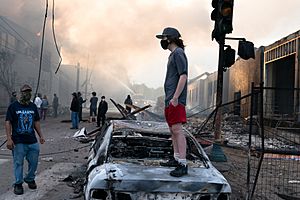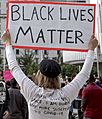George Floyd protests facts for kids
Quick facts for kids George Floyd protests |
|||
|---|---|---|---|
|
Some protest scenes in Minneapolis–Saint Paul
From top, left to right: Protesters in downtown Minneapolis, a protester standing on a damaged police vehicle, protesters with fists in the air outside the Minneapolis Police's 3rd Precinct, protesters overtaking and burning the precinct, protesters with police, armored police with the military, and demonstrators on a burnt street with firefighters working in the background. |
|||
| Date | May 26, 2020 – present (4 years, 11 months and 1 day) |
||
| Location |
Nationwide United States (protests started in Twin Cities, Minnesota)
Other cities worldwide in solidarity |
||
| Caused by |
|
||
| Methods | Demonstrations, civil disobedience, civil resistance, looting, assault, arson and property damage | ||
| Status | Ongoing | ||
| Parties to the civil conflict | |||
|
|||
| Lead figures | |||
|
|||
| Deaths, injuries and arrests | |||
| Death(s) |
|
||
| Injuries | Unknown | ||
| Arrested | 3,000+ | ||
The George Floyd protests are an ongoing series of protests and demonstrations against police brutality and racism in policing, which began in the United States in Minneapolis on May 26, 2020. These followed the killing of George Floyd, a 46-year-old unarmed black man, after Derek Chauvin, a white police officer, knelt on Floyd's neck for almost eight minutes during an arrest the previous day.
Unrest began in Minneapolis on May 26, 2020, after the killing of George Floyd. Floyd was killed after being arrested by officers of the Minneapolis Police Department (MPD) on May 25.
Protests spread to many cities in the United States.
Some of the protesters at the MPD's Third Precinct fought with law enforcement officers, who fired tear gas and rubber bullets. On May 27, one man was shot at a pawn shop and died, and the Third Precinct's windows were smashed. A supermarket was looted, and other buildings were attacked and set on fire. At least thirteen people have been killed so far because of the protests.
On May 28, Minneapolis Mayor Jacob Frey declared a state of emergency, and Governor of Minnesota Tim Walz called in 500 Minnesota National Guard troops. More businesses across the Twin Cities were damaged and looted.
MPD in the Third Precinct building attempted to hold off the protesters with tear gas, but around 11:00 pm, protesters overran the building and set it on fire. It had been evacuated.
Both Walz and Frey added curfews. U.S. President Donald Trump assured Walz of U.S. military support.
There were many attacks on journalists, both in the Twin Cities and at sister protests.
Protests
There were sister protests in all 50 of the United States and in the capital, Washington, D.C., Some of the protests were peaceful and others had violence and looting. The National Guard moved out into more than 25 of the nation's 50 states.
Many protests were peaceful but some turned violent. In some places, police remained calm, and in others they used force, tear gas, and rubber bullets. In Washington, D.C. one man let more than 50 protesters come into his house so they could escape from the police who were chasing them. Two weeks into the protests, 9300 people had been arrested in the United States, 1500 in in New York and 2700 in Los Angeles.
In Newark, New Jersey, 12,000 people protested over the weekend of May 31, but no one damaged any stores and no one was arrested. The Newark Community Street Team, which formed in 2014, worked to prevent violence. Newark city leaders said that the young black Americans among the protesters were the reason the protest stayed peaceful. Camden, New Jersey and Flint, Michigan also had peaceful protests.
Protesters outside the White House, the building in Washington, D.C. where the president lives, called for President Trump to resign. Some threw bottles. The United States Secret Service took President Trump to a bunker in the White House. On Monday, June 1, the Secret Service used tear gas on peaceful protesters outside the White House so President Donald Trump could walk to St. John Church and have his picture taken with a Bible.
On the weekend of June 6-7, protests in the United States were even bigger but mostly peaceful, according to The New York Times and the protesters were more unified in what they wanted: police reform. There were tens of thousands of protesters in large cities like New York and Seattle and also protests in smaller towns like Marion, Ohio and Vidor, Texas. New York City Mayor Bill de Blasio announced on Sunday morning that New York City was stopping its 8:00 p.m. curfew.
International protests
There were also protests outside the United States, in London, Toronto, Beijing, Berlin, Addis Ababa, Australia. New Zealand and other places.
Some of these international protesters said they wanted to support George Floyd but also draw attention to the racist actions by police in their own countries.
In Toronto, protesters remembered the death of Regis Korchinski-Paquet, a black woman who fell out of her balcony when the police were in her apartment.
Londoners protested outside a the Grenfell Tower where many blacks and Arabs died in a fire.
Parisians remembered Adama Traoré, who died after being arrested by French police.
Australians planned protests remembering David Dungay, an Australian Aboriginal man who died after being arrested. Dungay also said "I can't breathe," twelve times.
Some protesters have told their own leaders that they want new laws against racism.
Impostors
At least one white supremacist group, Identity Evropa, pretended to be on the protesters' side on Twitter. They said they were part of antifa and told protesters to loot white neighborhoods. They were caught, and Twitter took their posts down for breaking their rules about violence, spam, and fake accounts.
Other events
In Brooklyn, New York, video showed an officer pushing a seventy-year-old man. The man fell down and bled from his head. Both were white. The officer, Vincent D'Andraia had also hurt other protesters. He was suspended and charged with assault. D'Andraia was the first New York City police officer charged with a crime because of things he did during the George Floyd protests.
In Seattle, Washington, Nikolas Fernandez, 31, drove his car into a group of protesters and shot one man. He said he was afraid for his life because the protesters tried to grab him through his window. Firefighters took the man Fernandez shot to the hospital.
Images for kids
-
A George Floyd mural created by protesters in Portland, Oregon
-
Map of protests around the world with over 100 participants. Minneapolis-St. Paul is marked in red. (click for a dynamic version of the map)
-
A sign at the George Floyd Square occupied protest, May 18, 2021
-
On June 8, 2020, the police-free Capitol Hill Autonomous Zone was established in the Capitol Hill neighborhood of Seattle.
-
A protester being arrested in Columbus, Ohio, on May 30, 2020
-
Masked protesters in Philadelphia on June 2, 2020
-
Protest at Alexanderplatz in Berlin on June 6, 2020
-
Protesters in Eugene, Oregon, on June 9, 2020
-
Federal Reserve Chairman Jerome Powell noted on June 10 "historically high unemployment" prevalent during the prelude of the protests.
-
Vandalized monument of Confederate general Robert E. Lee in Richmond, Virginia, on July 1, 2020
-
The pedestal of a Christopher Columbus statue that was thrown into the Baltimore inner harbor on July 4, 2020
-
A protester in Vancouver, Canada, mentioning COVID-19 on their clothing
-
A protest march in Minneapolis on May 26, 2020
-
Protesters in Washington, D.C., in front of the White House on May 30, 2020
See also
 In Spanish: Protestas por la muerte de George Floyd para niños
In Spanish: Protestas por la muerte de George Floyd para niños




























